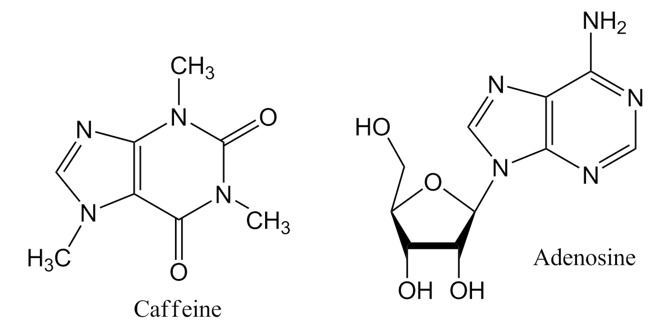Caffeine withdrawal can be extremely debilitating for many people. It can be the one factor that keeps a person from starting a detoxification program or cleanse. When managed properly, caffeine withdrawal can be practically effortless and painless.
Caffeine is the most widely used drug worldwide. In the United States, 89% to 96% of men and nonpregnant women older than 18 years consume caffeine from coffee (71%), tea (12%), and soft drinks (16%).1 Approximately 20% to 30% of Americans consume more than 600 mg of caffeine daily.2
Biochemistry
Caffeine is a methylxanthine. Like most other xanthines, it is a central nervous system stimulant, having both physical and mental effects. Blocking adenosine receptors in the brain is the primary way that caffeine acts as a stimulant given its structural similarity to adenosine (Figure). Adenosine is not a neurotransmitter but a neuromodulator. Adenosine receptors inhibit the release of neurotransmitters. The release of neurotransmitters is increased when adenosine receptors are blocked by caffeine, resulting in central nervous system stimulation.

Caffeine enters the bloodstream through the stomach and small intestines and can exert its effects in as little as 15 minutes. Caffeine is metabolized by the liver via the cytochrome P450 enzymes. The half-life for caffeine metabolism in adults is usually 5 to 6 hours. Caffeine withdrawal symptoms are usually felt within 24 hours after stopping caffeine.
Stimulatory effects of caffeine on the body include increased mental acuity, blood pressure, and heart rate. Over time, the false sense of energy as a result of consuming caffeine can take its toll on the adrenal glands. Using caffeine as a stimulant allows a person to ignore common signs of stress and overload. It is important to address potential suboptimal adrenal function in patients with long-standing regular caffeine habits.
The negative health effects of long-term regular caffeine use are numerous. They include anxiety, magnesium deficiency, chronic dehydration, increased inflammation, and sleep deprivation.
There is also growing research about the health benefits of caffeine. Caffeine consumption has been linked to decreased rates of certain types of cancer,3,4 Alzheimer disease,5 Parkinson disease,6 and diabetes mellitus.7 Caffeine use has been associated with lower rates of chronic liver disease caused by excess alcohol consumption, diabetes, obesity, and high iron saturation.8
Symptoms
Headache is often the most common symptom in patients experiencing caffeine withdrawal and is caused by adenosine receptors being more sensitive to adenosine once caffeine is removed. The increased sensitivity of adenosine receptors leads to dilation of blood vessels, which is the cause of headaches in caffeine withdrawal. Vasodilation also leads to a drop in blood pressure, which contributes to fatigue.
Physical dependence on caffeine is common. Many individuals require caffeine to wake up in the morning or to avoid withdrawal symptoms. Of course, not everyone experiences these symptoms or is dependent on caffeine. In addition to headaches, withdrawal symptoms can include fatigue, irritability, constipation, depression, muscle stiffness, lack of concentration, and even flu-like symptoms.
How do we help our patients to manage these symptoms when removing coffee from their daily morning or afternoon ritual? The best way to avoid withdrawal symptoms is to wean slowly. I often start weaning my patients off coffee and other vices a week before they start their detoxification. This is done during the predetoxification phase. Mixing regular coffee with decaffeinated coffee is a common way to wean. Coffee alternatives made with herbs, grains, fruits, and nuts can help to fulfill the need for a morning ritual. In addition, certain supplements can help to relieve symptoms of withdrawal.
Treatment
Magnesium helps to stabilize the vascular system and to relax muscles. Both of these effects are helpful to reduce headaches associated with caffeine withdrawal. Magnesium is also an important mineral for energy production by mitochondria in all cells of the body. The adrenal glands are particularly sensitive to magnesium deficiency, so supplementing with it helps to support the adrenals. Most patients who are dependent on caffeine have magnesium deficiency. Caffeine contributes to magnesium loss owing to its diuretic effects. Magnesium helps to reduce the muscle tension and headaches that patients experience.
Eliminating any B vitamin deficiencies is essential when weaning from coffee. B vitamins are crucial for energy production in the body and support the adrenal glands as well. Vitamin B12, in particular, is helpful for boosting energy when weaning from coffee.
I have found that the quickest way to help a patient who is experiencing withdrawal symptoms is with a Myers cocktail intravenous push, administered using a 35-mL syringe and pushed manually over 15 to 20 minutes. Many times, I have seen this immediately stop the headache associated with caffeine withdrawal. The key ingredient in the push that is helpful to these patients is the magnesium. The increased energy from the vitamin B complex and vitamin B12 is felt some time after the intravenous administration.
Supporting the adrenal glands during caffeine withdrawal is important, as they are often fatigued from regular caffeine use. Herbs to support the adrenal glands are adaptogenic and include, but are not limited to, Panax ginseng, ashwaganda, licorice root, maca, and Eleuthrococcus.
Optimal hydration is paramount when weaning from caffeine. Reminding patients to drink at least 64 oz of water a day will help to reduce the effects of caffeine withdrawal. Proper hydration also helps to minimize the common symptom of constipation. Fiber supplementation in conjunction with proper hydration can further help to prevent constipation. Also, reminding patients to eat regularly throughout the day, focusing on protein, can help to reduce blood glucose irregularities that can contribute to headache and fatigue.
Hydrotherapy is a treatment that the patient can do at home or in the office. For headaches associated with increased blood circulation to the head, it is recommended that the patient use the following hydrotherapy treatment: The feet are placed in hot water, and a cold damp washcloth is placed on the forehead. The patient is allowed to rest with these in place for 20 minutes or longer. The cold washcloth can be refreshed in cold water, wrung out, and replaced on the patient’s forehead as needed. This treatment helps to move blood to the feet and to relieve dilated blood vessels in the head.
Muscle tension can be relieved with bodywork. This includes massage, Chinese cupping, or gua sha, which all help to improve sluggish circulation. The use of these techniques should be concentrated in the head and neck area, as this is where most muscle tension occurs.
Last, I always advise my patients to ensure that they are getting at least 8 hours of sleep per night, especially when weaning from caffeine. This is to remove any other factors that can contribute to fatigue.
The patient should start taking the recommended supplements before beginning to wean from caffeine to help ensure that their withdrawal process is less uncomfortable. Caffeine withdrawal symptoms are sometimes unavoidable even with the most diligent protocol use. Patients are encouraged to rest when possible and should be reminded that they will emerge on the other side of the caffeine dependence with more energy and vitality than they had on their best days when drinking coffee every day.
 Erica Peirson, ND is a graduate of the National College of Natural Medicine. She came to Naturopathic Medicine with a background as an Emergency Medical Technician. Dr. Peirson now practices in Portland, Oregon, and specializes in fatigue, weight loss, thyroid disorders, anxiety, and dermatology. She also specializes in treating children with Down Syndrome. In addition to her practice, Dr. Peirson teaches Cell Biology and Anatomy & Physiology at Portland Community College.
Erica Peirson, ND is a graduate of the National College of Natural Medicine. She came to Naturopathic Medicine with a background as an Emergency Medical Technician. Dr. Peirson now practices in Portland, Oregon, and specializes in fatigue, weight loss, thyroid disorders, anxiety, and dermatology. She also specializes in treating children with Down Syndrome. In addition to her practice, Dr. Peirson teaches Cell Biology and Anatomy & Physiology at Portland Community College.
References
- Frary CD, Johnson RK, Wang MQ. Food sources and intakes of caffeine in the diets of persons in the United States. J Am Diet Assoc. 2005;105:110-113.
- Neuhauser-Berthold M, Beine S, Verwied SC, Luhrmann PM. Coffee consumption and total body water homeostasis as measured by fluid balance and bioelectrical impedance analysis. Ann Nutr Metab. 1997;41:29-36.
- Jordan SJ, Purdie DM, Green AC, Webb PM. Coffee, tea and caffeine and risk of epithelial ovarian cancer. Cancer Causes Control. 2004;15(4):359-365.
- Michels KB, Willett WC, Fuchs CS, Giovannucci E. Coffee, tea, and caffeine consumption and incidence of colon and rectal cancer. J Natl Cancer Inst. 2005;97(4):282-292.
- Eskelinen MH, Kivipelto M. Caffeine as a protective factor in dementia and Alzheimer’s disease. J Alzheimers Dis. 2010;20(suppl 1):S167-S174.
- Ross GW, Abbott RD, Petrovitch H, et al. Association of coffee and caffeine intake with the risk of Parkinson disease. JAMA. 2000;283(20):2674-2679.
- Zhang Y, Lee ET, Cowan LD, Fabsitz RR, Howard BV. Coffee consumption and the incidence of type 2 diabetes in men and women with normal glucose tolerance: the Strong Heart Study. Nutr Metab Cardiovasc Dis. 2011;21(6):418-423.
- Ruhl CE, Everhart JE. Coffee and tea consumption are associated with a lower incidence of chronic liver disease in the United States. Gastroenterology. 2005;129(6):1928-1936.

